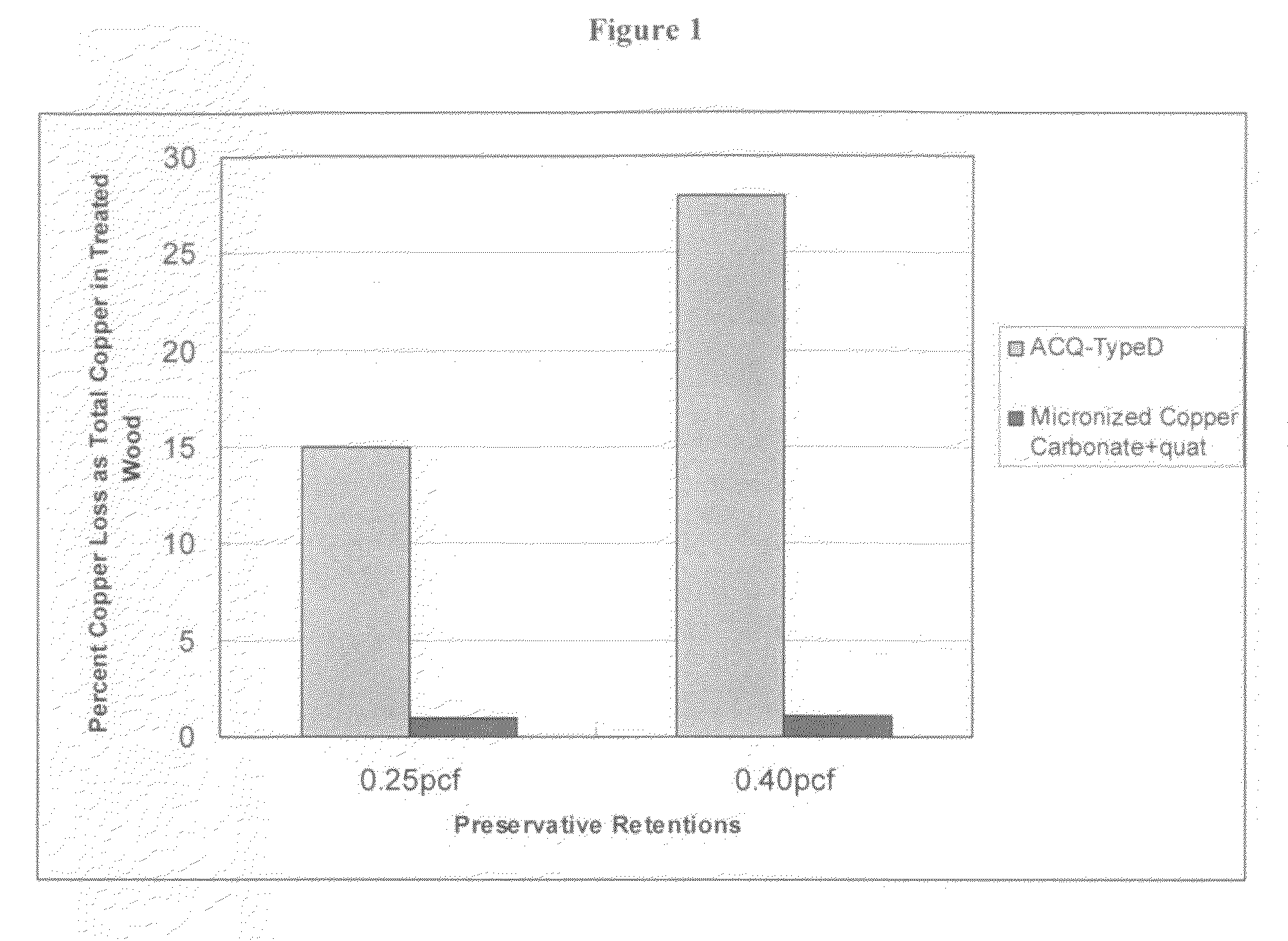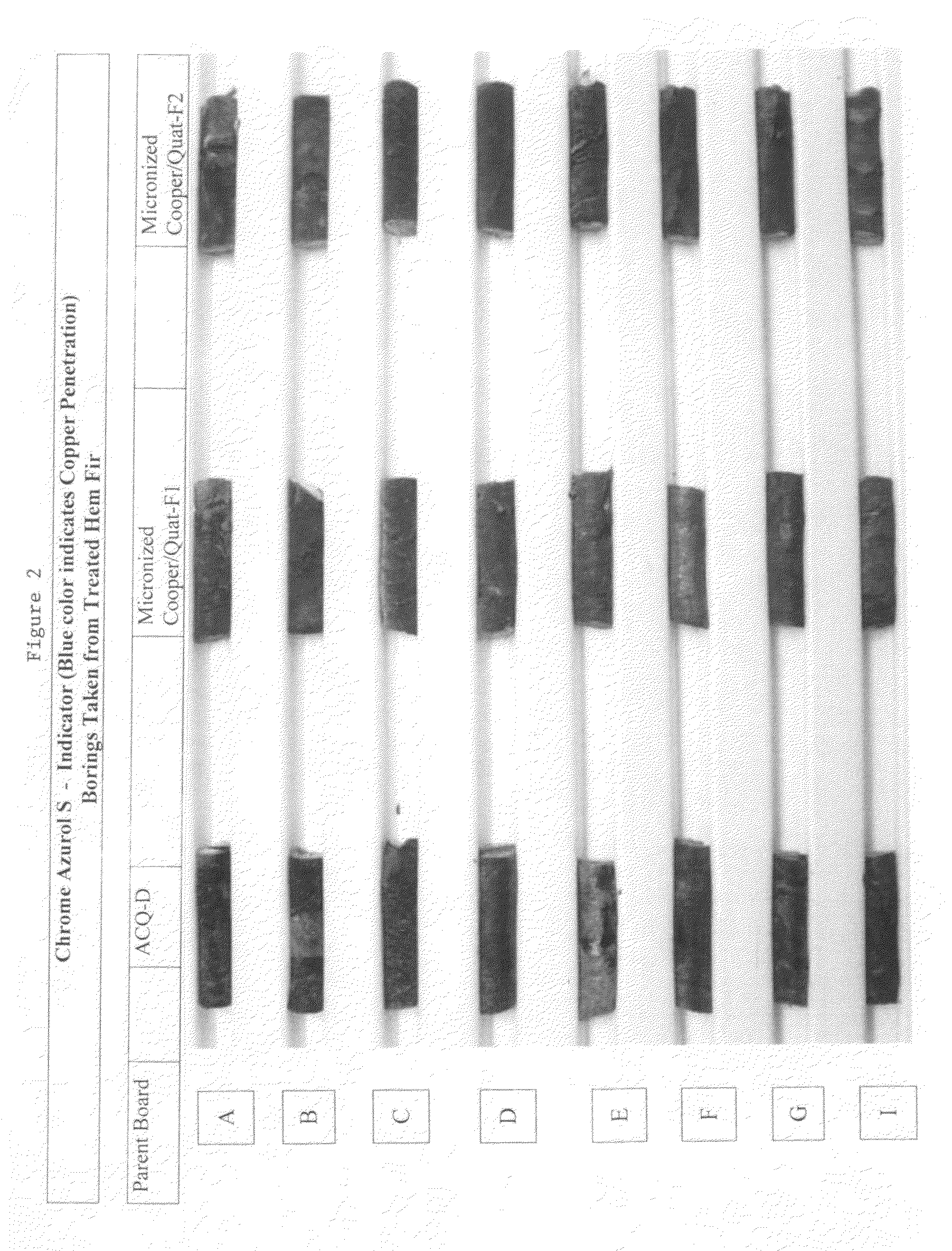Process for preparing fine particle dispersion for wood preservation
- Summary
- Abstract
- Description
- Claims
- Application Information
AI Technical Summary
Benefits of technology
Problems solved by technology
Method used
Image
Examples
example 1
IA—One-Step Grinding Process
[0126]A 5000 g slurry mixture containing 2500 g of copper carbonate, 450 g of commercially available dispersant and 2050 g water was mechanically stirred for 10 minutes and then placed in a lab grinding media mill where a 0.4-0.6 mm Zirstar beads was used. The lab mill was operated at an agitation speed of 2400 to 2650 rpm and a transfer pump speed of 100-150 rpm. The temperature of the slurry was at 30° to 50° C. A sample was taken every 10 minutes for particle size measurement. The particle size was measured on a Horiba LA-910 Particle Size Distribution Analyzer (PSDA). The grinding process stopped at 170 minutes when the target particle size was achieved. The target particle size was set at a mean particle=0.11 microns and 99.0% particles less than 0.3 microns.
IB—Two-Step Grinding Process
[0127]The same copper carbonate mixture was placed in the lab mill and milled as the same condition as described in Example IA. After 40 minutes grinding, the grinding...
example 2
II A—One-Step Grinding Process
[0129]A 4000 g slurry mixture containing 1800 g of copper carbonate, 360 g of commercially available dispersant and 1840 g water was mechanically stirred for 10 minutes and then placed in a lab grinding media mill where a 0.2-0.3 mm Zirstar beads was used. The lab mill was operated at an agitation speed of 2400 to 2650 rpm and a transfer pump speed of 100-150 rpm. The temperature of the slurry was at 30° to 50° C. Samples were periodically taken for particle size measurement. The particle size was measured on a Horiba LA-910 Particle Size Distribution Analyzer (PSDA). The grinding process stopped at 1080 minutes when the target particle size was achieved. The target particle size was set at a mean particle=0.080 microns and 99.0% particles less than 0.20 microns.
II B—Two-Step Grinding Process
[0130]The same copper carbonate mixture was placed in the lab mill and milled as the same condition as described in Example IA. After 30 minutes grinding, the grind...
example 3
III A—One-Step Grinding Process
[0132]A 6000 g slurry mixture containing 3000 g of copper carbonate, 540 g of commercially available dispersant and 2460 g water was mechanically stirred for 20 minutes and then placed in a lab grinding media mill where a 0.1 mm YTZ beads was used. The lab mill was operated at an agitation speed of 2400 to 2650 rpm and a transfer pump speed of 100-150 rpm. The temperature of the slurry was at 30° to 50° C. Samples were periodically taken for particle size measurement. The particle size was measured on a Horiba LA-910 Particle Size Distribution Analyzer (PSDA). The grinding process stopped at 600 minutes when the target particle size was achieved. The target particle size was set at a mean particle=0.080 microns and 99.0% particles less than 0.20 microns.
III B—Two-Step Grinding Process
[0133]The same copper carbonate mixture was prepared as Example III A, and then placed in the lab media mill where a 0.2-0.3 mm Zirstar beads was used. The lab mill was op...
PUM
 Login to View More
Login to View More Abstract
Description
Claims
Application Information
 Login to View More
Login to View More - R&D
- Intellectual Property
- Life Sciences
- Materials
- Tech Scout
- Unparalleled Data Quality
- Higher Quality Content
- 60% Fewer Hallucinations
Browse by: Latest US Patents, China's latest patents, Technical Efficacy Thesaurus, Application Domain, Technology Topic, Popular Technical Reports.
© 2025 PatSnap. All rights reserved.Legal|Privacy policy|Modern Slavery Act Transparency Statement|Sitemap|About US| Contact US: help@patsnap.com



